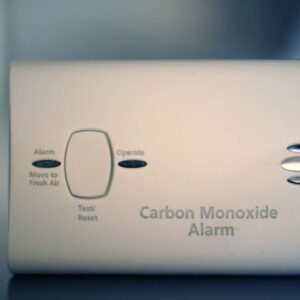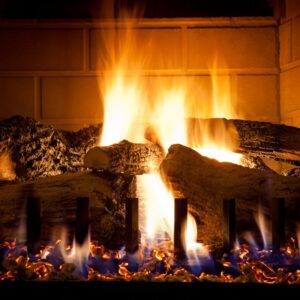As autumn presses onward and winter gets closer, the desire for a roaring fire in the fireplace begins to grow. Shorter days bring the need for more light, and the holidays inspire us to get those warm flames going strong. The one downside? Cleaning up messy ash piles and wood chips after the fact.
But hey – burning wood is no longer the only option when it comes to having a fireplace in the home. In fact, many people are turning their traditional wood-burning fireplace into gas log fireplaces.
There are a lot of reasons to consider a gas log fireplace, but making the switch is a big decision. And, of course, with big decisions come big questions. At Smalling Masonry, our experts are here to help. We wanted to share some of the most common questions we get – and provide you with the answers you’re looking for.
Looking to reach out? Call 317-903-8121 or schedule with us online now.
What Are Gas Logs?
Gas logs are ceramic, refractory cement, or ceramic fiber that is fashioned to look like traditional wood logs. When properly installed into your propane or natural gas line, gas flows through the logs, is ignited, and dances and flickers like a traditional wood-burning fire.
Gas logs come in lots of styles and can be installed right into your existing fireplace – with a few new components, of course. Much like a traditional fireplace, heat radiates from the flames and into your home.
How Do You Install Gas Logs?
Installing gas logs is not a simple do-it-yourself project. Because it involves your gas line, improper and amateur installations can lead to dangerous situations. Specialized knowledge and proper licensing in dealing with gas lines are required. Here are a few of the risks of installing gas logs on your own, no matter how good the YouTube video you’re referencing is:
 Gas Leaks: One of the biggest risks – and unfortunately one of the most common outcomes – of DIY installations, is gas leaks. Working with gas lines at any level requires training and certification. This is because the risk of gas leaks is highly dangerous. Not only does it create a high risk of fires and explosions within the home, it also elevates the concentration of carbon monoxide within the home.
Gas Leaks: One of the biggest risks – and unfortunately one of the most common outcomes – of DIY installations, is gas leaks. Working with gas lines at any level requires training and certification. This is because the risk of gas leaks is highly dangerous. Not only does it create a high risk of fires and explosions within the home, it also elevates the concentration of carbon monoxide within the home.- Improper Venting: Burning gas is odorless and clean. Even so, burning anything always creates byproducts that are harmful if not vented properly. Knowing how and where to vent – and also being able to inspect and repair weaknesses in the ventilation system – is a vital part of fire safety. Our experienced team of chimney technicians at Smalling Masonry can make sure that your home is safe and your new appliance is properly vented.
- Code Compliance: When installing a gas log fireplace, your local building codes should be taken into account. These vary by state and, sometimes, even locality. Knowing what is required under the law is key, and our experts at Smalling Masonry are well-versed in all necessary requirements.
- Warranty and Insurance: Many manufacturers and insurance companies require licensed professionals to install and be a part of maintenance routines in order to preserve warranties and coverage.
Can You Convert a Wood-Burning Fireplace to Gas Logs?
Yes – and it’s part of what makes switching to gas logs so appealing to so many. Gas logs have a lot of advantages in the efficiency and cleanliness departments. They don’t require a bundle of well-dried and seasoned hardwood to be at the ready, and they can be turned on and off with the flip of a switch.
…but perhaps the biggest perk is that it can maintain the beauty of your already installed fireplace.
If you are interested in converting your current wood-burning fireplace into a gas log fireplace it starts with a call to Smalling Masonry. Our tech will visit your home and provide an assessment of your fireplace and chimney or ventilation system. From there they will help you determine the right gas logs for you.
Vented vs. Ventless Gas Logs: What’s the Difference?
In the world of gas logs there are two primary types, and each has its advantages and disadvantages. What is right for you depends on what you want to emphasize with your fireplace. Here are the major things to think about with each.
Vented Gas Logs
 Vented gas logs are hailed for their realism and aesthetic. They provide a realistic flame pattern with tall flames that flicker like a traditional wood fire. And they are called vented gas logs for a reason – a chimney or ventilation system is needed in order to carry away emissions such as water vapor and carbon monoxide.
Vented gas logs are hailed for their realism and aesthetic. They provide a realistic flame pattern with tall flames that flicker like a traditional wood fire. And they are called vented gas logs for a reason – a chimney or ventilation system is needed in order to carry away emissions such as water vapor and carbon monoxide.
Because of the ventilation, much of the heat produced from burning is carried out through the system making them a less efficient heat source for the home than a ventless option. That being said, because the byproducts produced while burning have a place to escape, indoor air quality is better with vented gas logs.
Ventless Gas Logs
Ventless gas logs offer a smaller flame and more controlled flame pattern. They do not mimic a realistic wood flame in the same way that a vented gas log does. The big advantage to ventless gas logs, however, is that they don’t require a chimney or vent, and their heat output is very efficient.
The big concern with these is that the risk for hazardous fumes entering your home is increased (although not likely). It’s recommended to only run these units for a few hours at a time.
Call Us Today
Smalling Masonry would love to be your partner in fireplace and chimney installation, cleaning, and maintenance. If you are ready to make the jump from a traditional wood-burning fireplace to the convenience of gas logs, we are ready to help you.
Call us today at 317-903-8121 or reach out online for your assessment. Find out what will breathe new life into your beautiful fireplace.
